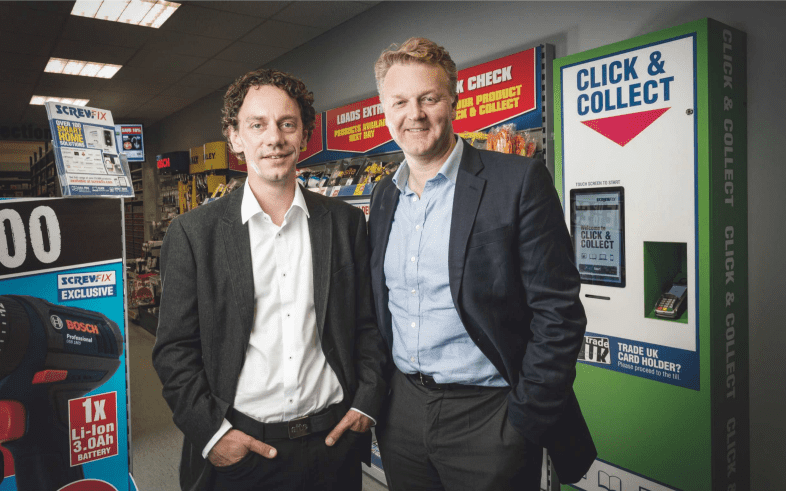Convenience, product leadership and value along with an aggressive expansion programme led Screwfix to significant growth in its last quarter. Andrew Livingston, CEO, and Andy Gault, Director of e-Commerce, Screwfix, spoke to Emma Herrod about how that translates for customers.
No company wants to disappoint a customer by being out of stock of an item they want to buy, not having their order ready when they want to collect it in store or simply not maintaining the quality of the products it stocks. And woe betide those retailers yet to offer a good mobile experience to customers looking for quick, convenient service. Savvy businesses know that the online customer is just one click away from ordering elsewhere and that social media allows a disappointed customer’s complaint to be spread far and wide.
You’re probably nodding in agreement, maybe recognising friction points in your own online or omnichannel business. So imagine what it’s like if you extend your service to customers who will actually lose money if you get their order wrong: small businesses, sole traders, plumbers, electricians, the general builder down the road. All of these are expecting the best practice, omnichannel service that they’d receive as consumers on the best B2C sites, but they just happen to be buying products for their business. That’s the pressure under which Screwfix delivers, 7 days a week.
“These guys are depending on us to make them money so the imperative is never to fail them,” says Screwfix CEO Andrew Livingston. “Time for them is money, and we never want to let anyone down.” This is reflected in the company’s aim to ‘help our customers get their jobs done quickly, affordably and right first time’.
This is backed up by the three pillars of convenience, product leadership and delivering incredible value.
A tradesman can be working across a range of locations when something crops up that means they need to buy additional material or deal with an issue for which they haven’t planned. In either case, it’s needed straight away. Hence the requirement for Screwfix to offer a service that’s swifter than next-day delivery. With order and payment completed online, tradesmen can collect their purchase from a store just five minutes later and be sure that the item is in stock and reserved for them.
Screwfix was set up with a store at its head office and original warehouse location. Over the past ten years, it has opened a network of 412 stores across the country enabling tradesmen either to purchase directly in the stores or to reserve and pay for items online before picking them up from the store of their choice.
Each store is set up and merchandised in exactly the same way so the experience is consistent for all customers. Just 10% of the space in each outlet is given over to selling space with the remainder comprising a warehouse holding 11,000 skus. A larger range is available online.
The benefits for the company are that more stock can be held in a smaller space than a traditional retail store and stock accuracy remains high. The first stores operated with the same order systems as the company’s contact centre and online operation. As Andy Gault, its Director of e-Commerce, explains, anyone can put technology in place to offer Click & Collect; Screwfix’s differentiator is being secure in the knowledge that it won’t let its customers down.
Because of the model it uses, its stock records are extremely accurate and updated in real time across all channels. Livingston says this factor is very important for its customers, since it means they are able to check the level of stock of individual items in any particular store at any moment in time. When a customer is logged onto the website, they are automatically shown the level of stock in their ‘usual store’ for the item they are looking at on the product page. They are also shown the level of stock for that item held in the closest six stores to their postcode.
This live stock check service is a huge part of the website, especially for site visitors using mobile devices, with 50,000 checks performed each day across all online channels. “Therefore, it’s vital that the integrity of the stock is high,” says Livingston.
It also means that should one part of a larger order be out of stock, the customer can decide whether to have all of the order delivered together or to split the delivery or collection.
Unlike other retail businesses, at which each customer may be attached to a particular store for pick up, Screwfix customers are working across a wide area so will visit many different stores, depending on where they are working, and pick up items for a number of jobs en route from one to another.
“Because an order can be placed online and be ready for collection in just five minutes, some tradesmen place orders from outside a store while eating their lunch, “ says Gault. With the Quick Shop facility online, customers simply enter the sku codes of the items they wish to purchase and then proceed straight to checkout to complete the process.
“We’re proud of our Click & Collect offering,” says Livingston, explaining how it has really driven convenience for customers. “By using their mobile phone to order and pay for stock, thus securing it for collection, it means they never have a wasted journey.”
Click & Collect is growing very quickly; it accounts for 70% of all web orders, six million orders have been placed via the service since it launched in 2011, with 80% of those placed by mobile being collected in store.
Screwfix also produces four paper catalogues a year (as well as digital versions for browsing online), something that is still “pretty critical” to the business, particularly when the working environment of its customers is taken into account. Building sites can be dusty and dirty and not necessarily where someone wants to use their mobile phone for a prolonged period to browse or be able to get a 3G signal to order online. But armed with the individual product codes from the catalogue, customers can make a brief call to the 24 hour call centre and ring through their order. “It’s key for us to get catalogues into people’s hands,” says Livingston, so the company is printing more than ever. “It’s at the heart of the business and will be with us for some time.”
MOBILE
Mobile, though, is the growth area for the business and a channel which it had to serve very early on. Many of its customers were ahead of the curve and early adopters of iPhones, especially electricians, according to Livingston. “Tradesmen tend to have the latest apps on their phones,” he adds, explaining how many customers effectively use their phone as a mobile office.
The level of mobile sales has risen 98% in the past financial year with 80% of these orders collected in store. But overall, says Gault, mobile conversion rates are lower than desktop. Customers dual screen, browsing on an iPad while watching television of an evening.
Without mentioning specifics, he indicates that things are improving, with the new, recently implemented checkout process helping to boost conversion and reduce friction points. This process has been simplified and reduced from 5 steps into a single page with customers completing the parts that are relevant to them as a new or returning customer. Many have multiple delivery addresses and picking which to deliver a particular order to now involves just a simple click, explains Gault.
Wasted time costs its customers money, so Screwfix really does have a case for putting them at the heart of its business. Livingston explains that while most of the firm’s customers are sole traders, small businesses and enthusiastic DIYers, it doesn’t distance itself from the retail industry or think of itself as a B2B retailer.
Gault says the company does concentrate on its individual customers. It has a single view of every one collated by their postcode since this is the first thing the customer is asked for when they orders via the 24-hour contact centre or at a store. It also records the postcode when orders are taken online, with customers having to be registered and log on to make a purchase. “It also means customers have a single view of us,” says Gault, “so it feels like one business.”
To highlight how the company really does care about the individual customer, Gault gives an example of one who was third or fourth in a queue to collect an order at a store and went on to Twitter to comment about the wait. The tweet was picked up by Screwfix’s contact centre which phoned the store manager. The manager then went and spoke to the customer to rectify the situation.
CONSISTENCY
The need for consistency is an issue that crops up time and again while speaking with Livingston and Gault, and it’s something that’s not exclusive to Screwfix. They explain that the company is very consistent in the experience it gives customers online, through the catalogue and across the store estate, and how everything is tied in to the same offer. “Consistency is the biggest thing for us,” says Livingston, and that applies to everything from stock to POS. Online is run from an Oracle ATG platform with content supplied by a Stibo master data management system.
Giving customers a simple, consistent and seamless experience across all channels is key, and Screwfix has found that the better it gets at delivering that kind of service the better it is for back of house and for customers. Customer convenience and the net promoter score increase as well as its financial results.
In its last financial year, ended 31 January 2015, the company reported 25.5% growth in turnover reaching £835m. Like-for-likes were up by 13.4%.
Its aggressive growth strategy has seen employee numbers increase by 900 in the past year to 8,000 in total and a new store opened every week for the past four years. This year, it will open 60 new stores. Screwfix still manages to have the feel of a small company, with store colleagues forming close teams and getting to know customers, the most frequent of whom visit a store six times a week. “The store teams care about Screwfix and the customers,” says Gault. Of the way in which head office works closely across all departments he says “you feel like you can put your arms out and touch all sides of the business”.
When a new catalogue is ready to launch, the senior team goes out to stores to talk about the new products. The launch also gives the business an opportunity to reboot – something which has been lost to other, faster moving sectors which have a continual cycle of new products.
In addition, Screwfix works closely with parent Kingfisher on cross-group developments.
The company has evolved from a direct model of paper catalogue and telephone ordering through the advent of online to mobile growth and omnichannel. Has the added pressure on the business of wasted time costing its customers money brought about the current level of service and convenience or is it something to which all retailers should aspire? As Screwfix has shown, providing a service where 9 out of 10 customers will recommend you to a friend really does pay.
ADDITIONAL INFORMATION
GERMANY
Screwfix is not just expanding in the UK. The company plans to open five more trial stores in Germany this year following the launch of a site in the country and four stores in the Rhine-Main area – in Offenbach, Hanau, Dreieich and Koblenz – in September 2014 . This follows the 2013 launch of Screwfix.eu, which mainly supplies expat communities and other customers who are already familiar with the brand. The company also operates online in the Republic of Ireland.
The German business is fully localised with a head office in Germany and the site ranged with 9,000 skus specific to the country. A full service is offered at the stores and online with Click & Collect and next-day delivery available. A central DC in Haiger, near Frankfurt, handles fulfilment and store replenishment; Kuehne + Nagel handles store replenishment with next-day delivery of orders to customers delivered by GLS.
Germany could become a big market for Screwfix since the country is the largest home improvement market in Europe and is not served by any other Kingfisher group company.
DELIVERY
Screwfix allows customers shopping online to collect their order just five minutes after paying from any of its 412 stores.
It also offers next-day delivery, 7 days a week, that’s free of charge for week-day delivery on orders over £50. For these orders the cut-off time for next-day delivery is 7pm, Monday to Friday, and 4pm at the weekend. Next day before noon and before 10am deliveries are also offered. “Sunday delivery is growing in popularity,” says Livingston.
Orders for delivery direct to customers are processed by the company’s DC at Trentham, which is currently being extended to support B&Q home delivery as well. Stores are replenished by a separate DC in Stafford. Store stock is replenished 5, 4 or 3 times a week depending on the location and requirement. During the peak trading period of September to November the frequency of store replenishment increases.





